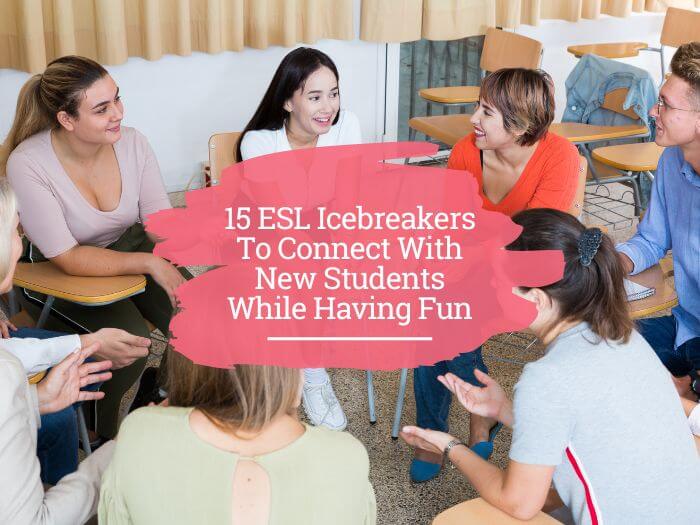Feeling nervous about your first day of class? Wondering how you will get your students to speak and get to know each other?
Then calm your nerves with this list of ESL icebreakers. These getting-to-know-you ideas and activities will help your students learn each other's names, have fun and feel more comfortable.
Some of the ESL icebreakers in this list work best in group settings, especially in-person. But many of them will work in individual and online settings too. So let's get into them!
Pro Tip
If you want to become a qualified online language teacher and earn a living from home, I recommend checking out CeOLT (Certificate of Online Language Teaching).
1. Two Truths And A Lie

This icebreaker is a classic. It will work in both group classes and 1:1 whether online or in person, on the first day or in subsequent classes too.
The idea is simple, you (yes you – building rapport with students means sharing something about yourself too!) and the learners write three sentences about themselves.
Two of them are true. And yes, you guessed it, one of them is a lie! The other members of the class need to figure out which pieces of information are true and which are false by asking follow-up questions.
You can see writing coach for non-native speakers, Philip Charter, use this icebreaker on LinkedIn to get people talking about him and themselves. Although it’s pretty obvious which of his statements is a lie!
2. Find Someone Who

This ESL icebreaker is another well-known one that works well in group classes.
Give the student a handout that looks like this (or write on the board):
- Has never been on a plane before ______________
- Isn’t on Instagram ______________
- Loves football _______________
You’ll want to add a few more prompts. Or even brainstorm them with the learners in class.
Once the handout is ready, they need to go round the room asking the others about the statements. When a classmate answers “yes”, they write their name in the gap. The aim is to fill out a name for each statement.
The game has two functions – to help the learners meet, talk and learn each other's names and to help them practise question formation. If the class has a low level, you may want to do some quick revision of how to form yes/no questions before starting this icebreaker.
3. The Cryptic Clue Guessing Game

I can’t remember where I first saw this activity but I have used it many times in both group and individual lessons with great results.
Write your name in the middle of the board in a bubble. From there, draw some arrows and at the end of each one, in a bubble, write a number/proper noun (person’s name, place name etc) connected to an aspect of your life. Get creative and cryptic! Here are some ideas:
- The number of your house/apartment
- Your shoe size! This could be especially tricky if you give your shoe size in US/UK sizes if that’s what you wear.
- The number of people in your family – this works well if you have a big extended family and a large number of cousins for example.
- A year that’s significant to you in some way. It doesn’t have to be the year of your birth (that might be a bit obvious anyway!).
- The last group/artist you saw live
- A city you visited last year
The students then have to ask you “yes/no” questions about the information until they guess the correct answer.
What’s especially fun is when they get to turn the tables on you and come up with their own cryptic guessing game.
A student once wrote 200 in one of her bubbles and I really struggled to figure out what it meant. It turned out she lived in a two-hundred square metre house!
4. Share And Discuss Meaningful Photos/Objects

Photos and objects can be excellent speaking and writing prompts to use on the first day or on subsequent days too. This activity works well in both in-person and online classes.
As a first-day icebreaker, ask students to find a meaningful photo that’s on their phone to show to their partner. They explain to their partner why it’s so important to them – perhaps it’s a photo of their family, or their favourite place.
You can also do this activity in online lessons, using the screen share function. Students can also choose a meaningful object in their home to hold up to the webcam and talk about.
5. Creative Corners

Ask students to divide a piece of paper into four and then give them these instructions:
- In the top left-hand corner, draw your favourite food.
- In the bottom left-hand corner, write something you like to do in your spare time.
- In the top right-hand corner, write the name of someone important to you.
- In the bottom right-hand corner, draw a dream you have for the future.
Students can then work in pairs or move about the room, asking their partners about what they’ve drawn/written to learn more about them. You can of course vary what you ask the students to write or draw in the squares.
In an online lesson, you could create a shared Google document with a grid in it and ask the student to write their answers in there. Drawing might be a little more complicated although they might want to share some photos in their grid!
6. The Hand Shaker

This one is super simple yet fast-paced and works well in group classes.
Get the students to stand up. Tell them that when you say “go” they’ll need to shake hands with each of their classmates, as fast as possible. When they shake hands, they’ll also need to ask the other person’s name and where they’re from.
The aim is for learners to go round the whole room and talk to everyone briefly. After they can try to write down the names of the people they talked to, and see how many they remember (probably not many!).
As this activity happens so fast, you can repeat it, asking students to speak to each other for a bit longer. Or to say their partner’s name first when they shake hands again.
7. Teach Your Language!

This simple but effective ESL icebreaker is perfect for multilingual classes either online (in breakout rooms) or in-person. And it would also work well in online 1:1 settings.
Students work in pairs and each of them teaches their partner to say “hello”, “goodbye”, “please” and “thank you” in their native language(s) or other languages they speak.
Afterwards, the partners can present the words they’ve learned to the rest of the class. Everyone will come out of the lesson having learned more than just English!
If you’re giving a 1:1 online class, asking your learner to teach you these words in their language can be an excellent way to build rapport and to feel closer to them.
Making yourself a little bit uncomfortable like this (because you’re bound to make mistakes) will give your learner the courage to speak up and make errors too!
8. Name Anagrams

This ESL icebreaker is great for learning names and getting their spelling right.
To start, write an anagram of your name on the (interactive) whiteboard. I would write “Yoll” or “Oloy”. Get the students to do the same thing with their names.
After, write their anagrams on the board and then ask them to try to unscramble them.
If you’re giving in-person lessons, you can ask the students to go around the room and ask the others if they’ve written their names correctly.
In an online lesson, you could put the students in breakout rooms in groups so they can do the same. Have them cycle through several groups until each student has talked to everyone.
By the end of this icebreaker, they should have talked to everyone and be able to pronounce and spell their names right!
9. Something Old, Something New, Something Borrowed, Something Blue

Have you heard the old wedding tradition: something old, something new, something borrowed, something blue? According to an Old English rhyme, a bride should have these four items on her wedding day.
You don’t have to send your students off to find these exact items. But the aim of this icebreaker is to get your learners to go on a scavenger hunt to find particular items around their home(s).
This activity works well in online lessons or even in-person 1:1 lessons (assuming you’re in the student’s home!)
Give them a time limit to find as many of them as possible. When they come back, they can talk about them with you or a partner and explain why they chose these particular ones.
For in-person lessons, students could try to find particular items in their bags or coat pockets or even in the classroom!
10. Guess The Question

Several of the ESL icebreakers in this list get the learners to form questions and this one is no exception!
This icebreaker will work in a first lesson either online or in-person and is particularly well suited to online lessons.
Before the lesson, create a table like the one below with the answers to questions about you. Screenshare this in the session, and ask your student to guess what the questions are.
This is actually the table our CeOLT trainers Chris and Katie use as an example with trainees.
| Question? | Chris | Katie |
| Poland | Taiwan | |
| Ireland | Latvia | |
| Ardbeg | coffee |
You can demonstrate how the game works like this: “If the answer is [your name], what’s the question?”
Let them guess the questions and then share some more information. Encourage your student to ask questions as well so that you turn this icebreaker into a conversation.
When this has finished, get your student to write three answers to questions about themselves. Give them a couple of minutes to do this, then proceed as before – guessing the questions, and then asking them follow-up questions to keep the conversation going.
11. Circles
This ESL icebreaker is a simpler version of the cryptic guessing game I mentioned before and can be adapted for use in online lessons, although it will work in-person and with groups too.
Your student will need a copy of the material below for this activity. To set the activity up online, share an editable Google document, and tell the student they need to write a short answer to each prompt in one of the circles.
You can demonstrate the activity by completing one or two circles with your answer to the prompts.
Tell them to write their answers in a random order, i.e. not top left, top middle, top right, etc. (otherwise there’s no opportunity to guess). Give them a few minutes to do this (and have a completed version for yourself ready to go).
When they’ve finished, take turns to share your screen and guess what each other’s answers refer to. Ask and encourage follow-up questions in order to keep the conversation going.
Material for this ESL icebreaker:
Write answers to these nine statements in any of the circles below. Write a short answer (one or two words).
- The town or city where you were born
- Your favourite book
- Your favourite town or city
- An important date in your life
- The first album you ever bought
- The last book you read
- Your favourite musical artist
- Your favourite film
- Your favourite day of the year
12. Other Half

This is another one of the many ESL icebreakers in this list that work really well in-person with groups.
Prepare a list of phrases or question-responses that go together such as “salt and pepper” or “how are you? Fine thank you”. Chop these phrases in half and then distribute them randomly.
Students move around the room asking questions to try to find their “other half”! When they do, they stand together in their pair and introduce themselves to each other and ask each other a few more questions.
You can re-do this activity by mixing up and re-distributing the pieces of paper once again. Your students will not only meet and learn about each other, but they’ll also learn some new phrases!
13. Something In Common

This icebreaker is a variation of “find someone who”. The learners write down three things they like, for example a type of food, a genre of movie and a country.
Then they move around the room asking the others if they like the same things. Their goal is to find someone who likes at least one of the things they like. When they do, they can chat to that person about it.
You can adapt this activity for online groups by putting the students in smaller groups in breakout rooms for a short time.
In a 1:1 lesson, you could create a longer list of items that you and your student both write about and then share afterwards. It can be fun to see what you have in common (or not!) and this is a great opportunity to ask lots of follow-up questions for speaking practice.
14. Noughts And Crosses

Teacher and translator Sarah Kingston shared this ESL icebreaker with me.
I love this icebreaker because it is very materials light, stimulates both receptive and productive skills, and can be adapted to almost anything and anyone. It's also a great format for making vocabulary games too!
Sarah Kingston
Draw the noughts and crosses grid on the board or whiteboard.
Method 1: Full group
Draw items in the boxes about you such as a flag to represent a language you speak. Don't the make them too easy and consider the level of your group.
Have the learners ask you questions to make guesses about your items to find out about you. Continue until they have discovered them all or you reach your time limit.
The students can do the same in pairs or small groups if they don't know each other, or for you as the teacher.
Method 2: Competition
Follow the same steps as method 1, but split the group and play noughts and crosses. Allow 2-3 questions before a guess for each box.
If they guess correctly, draw the O or the X as appropriate. This is good for a nice group who like to compete. You can also play teacher vs group which works well.
For 1:1
Using Method 2 can work well and helps you learn about each other while communicating and is a great opportunity for a covert diagnostic level test with your learner.
You can even each create your own grid and play both games simultaneously so that it doesn't get too one-sided. Of course, there's no need to compete either if that doesn't suit you or the learner.
15. A Non-Gamified Option

You can keep your first-day icebreakers simple if you don’t want to set up a game or provide handouts or spend time writing or typing on the board.
The easiest way to get people talking is to put them in pairs (or breakout rooms if in an online class) and ask them to chat for 10 minutes (five minutes each) about themselves and their lives.
While one student is speaking, the other takes a few notes, especially about interesting or surprising information.
After this discussion in pairs, students can then present their partner to the rest of the class (it it’s relatively small). Or you can put several pairs together to take turns to present in larger classes.
ESL Icebreakers
So there you have it – 15 ESL icebreakers to make your first classes with a new student or students go smoothly.
All of these activities will help you and your students get to know each other better, learn each other's names and feel more comfortable with you and each other.
If you’re feeling nervous before your first day with a new class, don’t stress. Everyone is in the same boat and no doubt your students are feeling apprehensive too.
So make day one easier on you and them by using these fun ESL icebreakers!

Olly Richards
Creator of the StoryLearning® Method
Olly Richards is a renowned polyglot and language learning expert with over 15 years of experience teaching millions through his innovative StoryLearning® method. He is the creator of StoryLearning, one of the world's largest language learning blogs with 500,000+ monthly readers.
Olly has authored 30+ language learning books and courses, including the bestselling "Short Stories" series published by Teach Yourself.
When not developing new teaching methods, Richards practices what he preaches—he speaks 8 languages fluently and continues learning new ones through his own methodology.










































